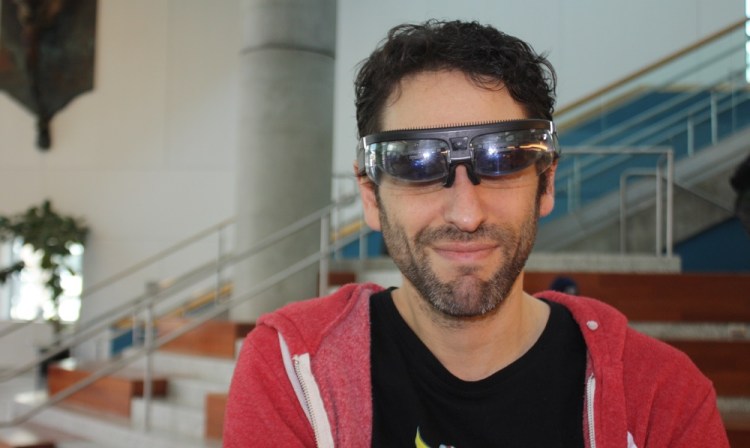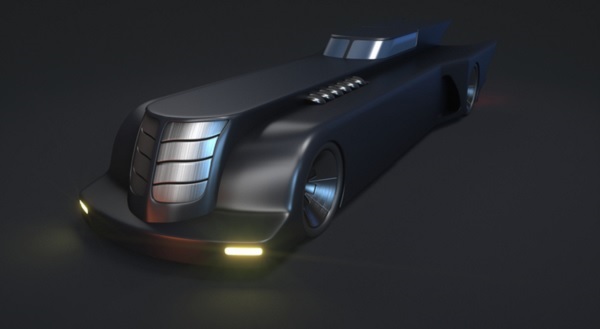GamesBeat: It’s sort of like a free version and a more powerful version.
Urbach: Yeah. The more powerful version is in the cloud. I think this whole space is going to be so big, especially for cinematic content. It’s not like the gaming content where you get motion sickness. This is a pretty obvious sell. Everyone from Warner Bros. to the NHL to individual artists, they want to have their stuff experienced in a better way. People make movies in IMAX because it fills more of your field of vision, because you really feel like you’re there. This does all that too. It gives that to the same space of users with mobile devices.
Carmack is focused on mobile VR. I am too. Companies like Magic Leap, and even Microsoft, these things are all really mobile devices. HoloLens is totally self-contained. This kind of effect, where you can look through this holographic window, is really interesting when you have AR tracking.
These glasses are prototype Osterhaut Design Group glasses. You may have seen them at CES. If you think of this thing as truly a window into a world–Imagine if you have an iPad where you’re watching a movie on it. Your screen can pull in a light field that would then be projected.
Here’s another demo. This is the Unreal engine running on Amazon, but you can see that I can control where the viewpoint is. If it’s a light field, which we’re just about to hook up, in that Keloid trailer or the Batman thing, you’ll be looking at it as a hologram. We’re waiting on this and that these other things to all converge. It’s going to be pretty awesome.
This is running in the cloud. The stuff you’ve written about before is this portion. We can load in anything in the cloud – Unreal Engine 4, our own light field stuff. The thing is, we may not need Unreal for these kinds of experiences. With the Octane 3 experience we announced yesterday, you’re going to be able to bake stuff into that. But the fidelity we get with a light field render is better than anything else. Either way, it’s the same principle. We render it in the cloud. It’s instantaneous. When I loaded the app, it connected and pulled down this demo. Because this is just a phone, we use the camera to do the tracking. That gives you some sort of position tracking, even on mobile.
GamesBeat: Where are you going with this?
Urbach: The next step is, we want to get this and our own viewer app to synchronize, so that when you’re in VR you can still plot something on there. It gives you both vectors of tracking. You can move the view point and then also move around as you’re wearing the glasses. We’re trying that with the ODG things. It’s getting there. It’s a little wonky. This is just a prototype. But I think that HoloLens and Magic Leap won’t need markers.
The thing is, you’re wearing those glasses, and you also want this thing here, or you want it in the palm of your hand. Imagine the hockey demo, or a UFC match is a good example. You’re watching a UFC match in VR mode. You can’t see the room around you. But with HoloLens or Magic Leap, you have it in the palm of your hand. If you want to go to the fridge or something, you can watch the game while you’re doing that. That kind of stuff is insanely cool.
That’s the future of live events. For cinematic stuff, though, VR is perfect. You don’t want to see anything else. You want to get the story. You want to immerse yourself in it. That’s why cinematic VR, even on mobile, is so compelling. We’ve hit a sweet spot in this collaboration with getting our renders into Gear VR this way. There’s nothing that’s going to get you close to that other than this process.
I was talking to some guys from Pixar at the booth. They said, “We want to use this format, but we don’t want to use Octane.” I said, “All right. You want to use Renderman. How long does it take you to render one megapixel? We need to render 18K by 2K, like 40 megapixels.” That’s about 100 hours for them. You’re not going to get into this thing unless you switch to a faster renderer.
That’s one of the reasons why we have it dual-purpose. We have to get Octane to be adopted. That’s one reason we went all-out with all the features. There’s nothing in Octane 3 that would make somebody not want to switch. As people see this is an emerging medium, we’ll have success getting them to go over to a faster renderer, more than we ever did just doing faster rendering of films.
GamesBeat: The Batman assets, that’s a 2D film. How does a company go about saying, “Hey, we want to make this 3D”?
Urbach: You definitely don’t want to start with older things that are drawn in 2D. Batman was a 2D cartoon, but we rebuilt it all in Octane as a 3D scene, as if it were something re-rendered in full CG. We just made it look like it was drawn by the original guys. That’s why you look at the intro and think, “Oh, this is a really cool 2D version.” It’s actually not.
If you want to have a look, this is the inside of the Batcave. It looks like it’s hand-drawn, but it actually has this immersive feeling going on, which is pretty cool. There are so many fans of this TV show. Warner Bros., for whatever reason, stopped the cartoon in 2004. I was like, “This is the only version of Batman I care about!” Finally, because we lucked into this project — Warner Bros. said, “We’ll bring that version of Batman back in VR.” We went from 300 Twitter followers to 30,000, just because of that announcement. People were writing us emails. “You better have the voice of Mark Hamill!” Because he said he’d never do the voice of the Joker again.
My role in a lot of our work right now is evangelizing this stuff. Sometimes it’s paid off in these crazy ways. In some respects — we wouldn’t have done the NHL thing if I hadn’t been pushing on this. “Look how amazing this is. Let’s get this implemented and make it happen for tennis, hockey, and UFC.”
GamesBeat: Your tools are useful beyond VR?
Urbach: There’s a bigger story than just the VR side of things. You see the pieces of that with these various different players in the mix. Microsoft’s HoloLens is not just about the media or the games. It’s also about the apps. They’re showing things like Skype and 3D modeling apps and Minecraft. I know Google is building a team called Android VR. But they’re all looking at a bigger thing called immersive computing, which is really just computing without being limited to a square that’s physically in front of you.
To me, that is the big step up from mobile. First we went from PCs to mobile devices. It’s not really just wearables that’s the next thing, not just VR. Those things are very narrow parts of something where there is absolutely no barrier between what you’re seeing in front of you and your eyeballs. All these devices are attacking this problem from different angles. But the operating system of the future is going to be something like that. It’s not going to be Google Glass or just Oculus, necessarily. That’s why there are different takes on it.
The guys that are taking it most seriously are Microsoft, with HoloLens, and Magic Leap. Magic Leap has been very clear. They’re not just going to create experiences. Apps are going to be written for it. I think they’re right. Whoever gets there first and gets developer mindshare, like Apple, will have an insurmountable lead. A thousand developers started with iOS and stuck with it, and they do their stuff right.
Microsoft or Facebook — any of them could win. But the guys who are focused on the AR space are going to get furthest first. It’s much harder to do, and it’s much easier for me to imagine turning this device into that, just by blocking out the lenses here. I thought maybe Magic Leap would get there first, but I don’t think they have that working yet. Somebody will. You’ll have one device for both, and then it’s going to get cool.
VentureBeat's mission is to be a digital town square for technical decision-makers to gain knowledge about transformative enterprise technology and transact. Learn More






